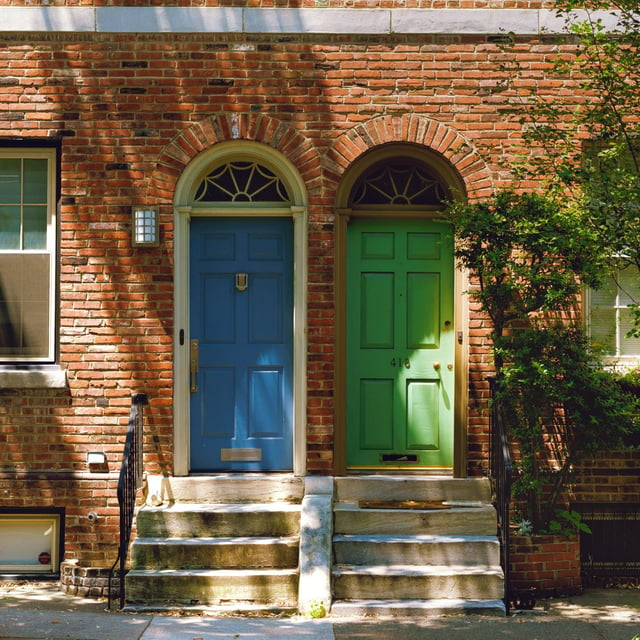
Philadelphia
Renovating Philly Row Homes: Contractors & Getting Started
08.20.2025

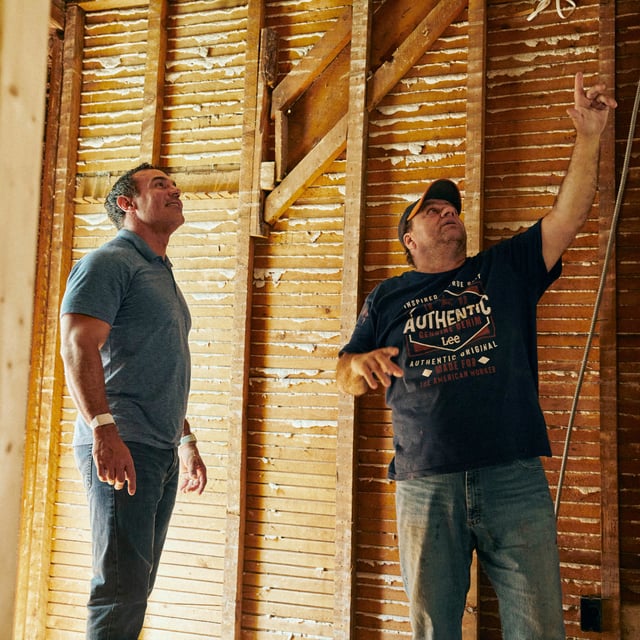
In This Article
Considering a complete overhaul of your home? A gut renovation could be the transformative project you're looking for. In Greater Philadelphia, where homes often boast historic charm, gut renovations let you modernize interiors while preserving the character of the property. Here's what you need to know to tackle this type of renovation with confidence.
If you've ever thought about completely reimagining a space down to the studs, you've been thinking about a gut renovation. Essentially, a gut renovation is a major overhaul that goes beyond a typical remodel. It involves stripping a property to its bare bones—removing walls, floors, insulation, plumbing, and sometimes even wiring. From there, it's like starting fresh with an empty shell, allowing you to redesign each room with modern updates, improved layouts, and brand-new finishes.
For many, a gut renovation is about creating their dream home without moving to a new location. In a place like Greater Philadelphia, where the architecture and character of older homes are cherished, a gut renovation lets you keep the charm while adding modern convenience. It's also an opportunity to address any underlying issues, like outdated plumbing or old electrical systems, that might not be immediately visible. While a gut renovation is a big undertaking, the results can be transformative, often breathing new life into an older property and making it more efficient, comfortable, and better suited to today's needs.
There are two main types of gut renovations to consider: full gut renovations and partial gut renovations. Your choice will depend on your goals, budget, and the property's current condition.
A full gut renovation is as extensive as it sounds. This type of renovation involves stripping down the entire property, removing all non-structural elements, and often addressing structural elements as needed. Walls, floors, ceilings, insulation, plumbing, and electrical systems all come out. In many cases, it's like taking the house back to its framework, giving you a fresh slate for customization.
For example, a full gut renovation is ideal if you've bought an older home that hasn't been updated in decades. It's also a smart option for those who want to transform the layout completely, perhaps by creating open-concept spaces or adding extra rooms. Since everything is being replaced or updated, a full gut renovation gives you control over the property's look, feel, and function from top to bottom. However, keep in mind that this is a major investment, requiring a substantial budget, careful planning, and time. But for homeowners ready to commit, the result is a custom-designed space that feels brand new.
On the other hand, a partial gut renovation allows you to target specific areas of the home without overhauling everything. In this case, you might only renovate a section of the property, like the kitchen and bathrooms, or you might focus on updating the main living spaces while leaving the bedrooms largely untouched. Partial gut renovations are a good middle-ground option if you're working within a tighter budget or if only certain areas need significant updates.
For instance, if your Philly kitchen and bathroom need a full refresh, but the rest of the home is in good shape, a partial gut renovation can deliver the updates you want without the larger commitment of a full renovation. Partial renovations are also popular among homeowners who want to make phased improvements, tackling one area at a time to spread out the work and cost. While not as intensive as a full gut renovation, a partial renovation can still make a big impact, modernizing key areas that may have started to show their age.
Whether full or partial, gut renovations are exciting opportunities to make a space your own. Whether you're looking to transform a home or make targeted updates completely, understanding the scope of your renovation can help you make the best decisions for your space and your budget.
A gut renovation involves multiple stages, each critical to achieving the final look and functionality you’re after. Here’s a breakdown of each step to give you a sense of what’s ahead when taking on this type of project.
Demolition is where the transformation really begins. At this stage, everything that won’t be part of the new design gets stripped away: walls, ceilings, flooring, cabinets, fixtures—anything outdated or not fit into the new plan. A full gut renovation could mean taking the home down to the studs and subflooring. It’s a messy process, but it clears the way for new possibilities.
Once demolition is complete, structural changes come into play. This phase is where you’ll see major alterations in layout, like moving walls, raising ceilings, or even adding new spaces. Structural changes might also involve reinforcing beams or floors, especially if you’re opening up rooms or creating an open floor plan. Working with an experienced contractor is key here, as any structural adjustments need to follow local codes and ensure the stability of the home.
With the structure set, it’s time to focus on the “behind-the-scenes” systems that keep a home running smoothly. This includes updating plumbing, electrical wiring, and HVAC (heating, ventilation, and air conditioning). In older homes, these systems may need a full replacement to meet modern standards and handle today’s appliances. Upgrading these elements improves efficiency and enhances safety and reliability in the long term. Getting these systems right is essential, as they’ll be much harder (and costlier) to update once walls and finishes are in place.
After the main systems are in place, insulation and drywall go up. Insulation helps control temperature and sound, making the home more energy-efficient and comfortable. Proper insulation is particularly important in gut renovations, especially when working with an older property. Once insulated, drywall is added to create the new walls, bringing shape and definition to the rooms. This stage gives a sense of the layout’s flow and helps the space feel more like a home again.
Finishing touches are all about adding value and aesthetics to your space. This final step includes installing cabinetry, flooring, lighting fixtures, paint, and any custom features that make the home uniquely yours. It’s the stage where your vision comes to life with details that elevate the design, like high-end finishes, quality hardware, and any special touches that reflect your style. The finishing touches may take time, but they turn a newly renovated structure into a truly personalized, welcoming space.
Completing a gut renovation is a journey that requires patience and planning. With each step, your vision of a dream home becomes closer to reality. By understanding the stages involved, you’ll be better prepared to tackle the project and enjoy the results for years to come.
Tackling a gut renovation in Greater Philadelphia? Getting to the finish line means starting with the right paperwork. Permits and zoning requirements are essential to keep your project on track and avoid costly penalties. Let's break down what you need to know about navigating these processes to make sure everything goes smoothly from start to finish.
In Philadelphia, permits and zoning approvals are critical for any gut renovation. Permits cover various parts of the renovation, including demolition, plumbing, electrical work, and structural changes. You'll likely need a construction permit for the actual renovation work and possibly additional permits for specific updates like HVAC or plumbing.
Applying for permits can seem overwhelming, but it's a crucial step to ensure your project meets local building codes, safety standards, and environmental regulations. Working with an experienced contractor can help streamline the application process, as they often know exactly which permits are necessary for your specific project.
Zoning requirements are also essential to understand before diving in. Zoning laws regulate how land and buildings can be used, affecting your renovation plans significantly. For instance, Philadelphia's zoning code will dictate if you can change a property from residential to commercial use or if there are restrictions on additions or structural changes. Zoning can impact even smaller projects, like adding a deck or changing the exterior appearance of a home. Checking zoning requirements early on ensures that your renovation complies with local regulations, saving you from unexpected setbacks down the line.
Greater Philadelphia is known for its historic homes, and renovating these older properties brings unique requirements. If your property has historic status, you'll need to follow specific guidelines to preserve its character. The Philadelphia Historical Commission oversees historic properties and has rules to maintain designated buildings' architectural integrity. For example, you might be restricted on the materials you can use or be required to preserve certain features like facades, windows, or rooflines.
Renovating a historic home can feel like balancing modern updates with preserving history. To make the process smoother, it's helpful to consult with both your contractor and the Historical Commission before making big design decisions. They can guide you on what's allowed and suggest ways to modernize while staying true to the home's original character. Keep in mind that approvals for historic renovations may take longer than standard permits, so budgeting extra time is wise.
Nothing puts a damper on a renovation like unexpected code violations. Code violations can delay your project, add unexpected costs, and even result in fines. Common issues include improper insulation, inadequate fire safety measures, and non-compliant electrical or plumbing work. To avoid these pitfalls, ensure every aspect of your renovation meets Philadelphia's building code standards. This includes everything from structural changes and wiring to plumbing and insulation.
One of the best ways to prevent code violations is to work with a reputable contractor familiar with local regulations. They can identify potential issues before they become problems and ensure that all work meets code. If you're taking a DIY approach to some parts of the renovation, double-check the requirements for any changes you make. Getting an inspection done after each major phase of the renovation can also help catch any potential violations early so you can address them before they turn into costly problems.
Navigating permits and zoning may feel like a lot of red tape, but these steps are crucial to ensuring a safe, compliant, and successful gut renovation. With the right preparation and knowledge of local requirements, you can keep your project on track and avoid headaches.
Taking on a gut renovation in Philadelphia? It’s no small task, and the costs can vary widely depending on the scope of your project. From professional installations to DIY upgrades, understanding what to expect can help you budget more accurately and plan effectively. Here’s a look at some key expenses to consider, starting with a closer look at bathroom gutting and installations.
Hiring a professional to handle a bathroom installation in a gut renovation can bring peace of mind, knowing that every aspect meets code and functions smoothly. In Philadelphia, a professionally installed bathroom typically ranges from $10,000 to $25,000, depending on the finishes, fixtures, and level of customization you choose. Factors such as plumbing and electrical work, custom tile, and luxury fixtures can increase costs, especially in older homes needing additional updates to meet modern standards.
The beauty of working with a professional is that they coordinate all these details, from selecting materials to managing timelines and inspections. With experts on the job, you’re less likely to face delays or unexpected problems, and you can be confident the work will be done to last. For those with the budget, a professional bathroom installation offers a higher level of quality, durability, and design flexibility, and the investment often adds significant value to the home.
If you’re looking to save on costs, a DIY bathroom addition can be an option, but it’s important to go in with realistic expectations about time, effort, and expertise required. For a DIY bathroom addition in Philadelphia, the cost typically falls between $5,000 and $10,000, with savings largely coming from reduced labor costs. This option can be attractive if you’re comfortable tackling basic tasks like tiling, installing fixtures, and painting.
However, it’s important to be cautious with aspects like plumbing and electrical work, as these are areas where code compliance is essential. Hiring a licensed plumber or electrician to handle these parts can add to the cost, but it also ensures your bathroom addition meets safety standards and functions properly. Even with some professional help for key elements, a DIY bathroom can still cost less than a full professional installation, making it an appealing option for homeowners on a budget.
Whether you choose a professional installation or take a DIY approach, understanding these costs upfront can help you make informed decisions for your Philadelphia gut renovation.
Planning a gut renovation is exciting but requires a clear understanding of the timeline to keep expectations realistic. From initial designs to final touches, each stage of a gut renovation has its own timeframe, and knowing what's involved in each phase can help you stay organized and on track. Let's break down the typical steps in a gut renovation so you know what to expect at every point along the way.
The first phase of any gut renovation is planning and design, and this is where you'll make the most important decisions about your space. This stage usually takes between 1 to 3 months, depending on the complexity of your project and how quickly you make decisions. During this time, you'll work closely with architects, designers, and contractors to map your vision. This involves drawing up floor plans, selecting materials, and choosing fixtures and finishes. The planning stage is also when you finalize your budget, so it's crucial to take your time here and make thoughtful choices to avoid costly changes down the road.
The planning phase also includes applying for permits, which is often necessary for any major renovation. In Philadelphia, getting permits for a gut renovation can take several weeks to over a month, so starting this process early is wise. Working with a knowledgeable contractor or architect who understands local regulations can help smooth this process and prevent delays.
Once you have a solid plan and the necessary permits, it's time to move into demolition and rough construction. This stage is where the real physical transformation begins, and it typically takes 2 to 4 weeks. During demolition, walls, flooring, and other elements that won't be part of the new design are removed, clearing the way for a fresh start.
After demolition, rough construction begins. This can include structural changes such as reinforcing walls, adding beams, or altering the layout. If you're making significant changes to the layout, rough construction could extend for a few additional weeks. Demolition and rough construction may seem messy, but they're crucial parts of the process that set the foundation for everything to come.
With the space's framework established, the next step is installing or updating the essential systems: plumbing, electrical, and HVAC. This phase is critical to ensuring your home's "invisible" elements are functional, safe, and efficient. Typically, this stage takes 2 to 3 weeks, but it could extend longer if you're working on an older property that needs significant upgrades to meet current codes.
Plumbing work can involve installing new pipes, water lines, and fixtures. Electrical work includes adding wiring, outlets, lighting, and any required updates to meet code standards. Finally, HVAC work focuses on heating, ventilation, and air conditioning, ensuring your home will stay comfortable year-round. Using licensed professionals for this phase is essential, as mistakes with these systems can lead to costly issues down the line. This is also the time to pass the first round of inspections, so you'll want to ensure all systems are in top shape.
Once the plumbing, electrical, and HVAC systems are in place, it's time to focus on framing, drywall, and insulation. This stage is where your new layout starts to take shape, typically taking 1 to 2 weeks to complete. Framing includes adding new walls or structural supports, which provide the shape and structure for the new design.
With framing in place, insulation is installed to help with energy efficiency and soundproofing, keeping your home comfortable and quiet. After insulation, drywall is added to create walls and ceilings, finally bringing the space to life. At this point, rooms will start to look more like the finished product, giving you a real sense of the new layout and flow.
Now for the exciting part: finishing work. This stage is where you'll see the most dramatic transformation, and it typically takes between 4 to 8 weeks, depending on the details of your renovation. Finishing work includes installing flooring, cabinetry, countertops, fixtures, and final paint or wallpaper. This is also the time to bring in any custom features, such as built-in shelving, fireplaces, or specialty lighting.
Each aspect of finishing work requires attention to detail to ensure a polished final look. For example, flooring must be carefully installed to avoid gaps, while cabinetry and countertops must be fitted precisely to match the design plan. This is a time-consuming phase, but it's also the most rewarding, as all the choices in planning and design come together.
The last step in a gut renovation is passing final inspections and getting sign-off. Inspections are essential to ensure that all work meets building codes and safety standards, covering everything from structural elements to electrical and plumbing systems. Depending on your location and the extent of the renovation, this phase can take anywhere from a few days to a week.
In Philadelphia, inspections might include checks by various departments, each focusing on different aspects of the renovation. Passing these inspections is crucial, as any issues found at this stage could delay completion and lead to extra costs. Once everything is approved, you'll receive the final sign-off, officially wrapping up the project.
By following these stages, you'll have a clearer view of the timeline for a gut renovation. With careful planning, patience, and attention to each phase, you can turn your property into the space of your dreams, one step at a time.
Planning a gut renovation is exciting, but success hinges on a few key steps. Here's a breakdown of essential tips to ensure your renovation goes smoothly, stays on budget, and delivers the results you envision.
A successful gut renovation starts with detailed planning and realistic expectations. Take the time to list your priorities, establish a timeline, and understand the scope of work. Setting achievable goals helps keep the project on track and reduces the risk of unexpected issues. From layout designs to finish selections, thorough planning is your foundation for a renovation that meets your needs and stays within budget.
Safety and structural soundness are non-negotiable in a gut renovation. Ensure your plans include proper reinforcement for walls, floors, and load-bearing elements. Ignoring structural updates might save money initially, but it can lead to costly problems down the line. By prioritizing these essential aspects, you'll create a safe, long-lasting space for years to come.
Hiring knowledgeable professionals is crucial to a smooth renovation. Experienced contractors, designers, and architects understand the complexities of gut renovations and can guide you through each phase, from obtaining permits to coordinating inspections. Choosing experts with local experience also helps ensure compliance with Philadelphia's regulations so you can feel confident that the work meets all standards.
In any renovation, surprises can (and often do) arise. Budgeting for these unexpected costs is essential to prevent stress and stay financially prepared. Set aside at least 10-20% of your total budget as a contingency fund. This way, if issues like hidden mold, outdated wiring, or structural repairs come up, you'll be ready to handle them without derailing your project.
The materials and finishes you choose impact your renovation's look and durability. Investing in high-quality materials for flooring, cabinetry, and fixtures will pay off in the long run. Quality finishes improve the overall aesthetic and withstand daily wear, reducing maintenance and replacement costs over time. It's worth spending more upfront to ensure a polished, enduring result.
Permits and paperwork are an unavoidable part of any gut renovation. Keeping these documents organized helps avoid delays and ensures a smooth inspection process. Maintain a dedicated folder for all permits, contracts, receipts, and communication with your contractor. Staying organized makes it easy to access information when needed and keeps the project moving forward without unnecessary interruptions.
If your gut renovation affects your entire home, you'll likely need alternative living arrangements. Make a plan early, whether it's staying with family, renting a temporary place, or setting up a small livable space in the home. Having a plan for where you'll live during construction makes the experience more manageable and reduces stress.
Once construction wraps up, schedule a final walk-through with your contractor. This is your chance to review the work, ensure everything matches the agreed-upon plan, and catch any issues that need adjustments. A thorough walk-through lets you address last-minute details and ensures your renovation ends on a high note, with no unfinished business.
When planning a gut renovation, it's important to expect the unexpected. Challenges can arise at any stage, from uncovering hidden issues to managing budgets, and understanding these potential obstacles will help you tackle them more smoothly. Here are some of the most common challenges you may face during a gut renovation.
Unforeseen issues are practically a given in any gut renovation, especially with older homes. Once walls are opened up, contractors often discover outdated wiring, hidden water damage, or structural issues that weren't visible before. These surprises can add both time and expense to your project.
For example, if outdated wiring is discovered, it must be replaced for safety and meet current building codes. Similarly, hidden mold or water damage often requires specialized remediation, which can be costly and time-consuming. Having a contingency fund and mentally preparing for these surprises can help you handle them without disrupting the entire project.
Historic homes add another layer of complexity to gut renovations. These properties often have requirements that dictate which elements must be preserved or restored. Older homes may also have unique construction methods or materials that are difficult to work with by today's standards.
For instance, certain architectural details or materials, like original plaster or hardwood, require skilled labor to preserve properly. In many cases, you may also encounter design limitations that prevent you from altering certain aspects of the home, even if they don't align with your modern preferences. Understanding these challenges ahead of time helps you manage both expectations and costs when renovating a historic home.
Renovation projects rarely go exactly as planned, and managing delays and extra costs can be a significant challenge. Material shortages, contractor schedules, and permit processing times can all impact your timeline. Extra costs also come into play when changes are made mid-project or unforeseen issues demand additional resources. To manage this effectively, consider building a buffer into both your timeline and budget.
You can navigate these challenges without feeling overwhelmed by setting realistic expectations and preparing for potential setbacks. Regular check-ins with your contractor can also help you stay updated on progress and address any issues before they escalate.
Philadelphia is known for its beautiful, historic homes; many homeowners want to preserve that charm even as they upgrade their properties. Balancing modern comforts with historical integrity requires careful planning, particularly if your home has architectural significance. Here's how to keep the essence of a historic property while making it functional for today's lifestyle.
One of the key challenges in preserving a historic home is finding the balance between modern updates and maintaining its original charm. You may want an open floor plan, but the home's layout and structural integrity might not allow for it. Work with what's already there instead of forcing changes that clash with the home's character. For example, consider retaining original features like crown moldings, fireplaces, and hardwood floors while updating essential systems like plumbing and wiring to ensure safety and comfort. Working with an architect or contractor experienced in historic renovations can also help you create a design that respects the home's history while introducing contemporary conveniences.
Sourcing materials that match the home's original design is another key part of preserving its character. In some cases, modern replicas may be available, but often, you'll need to find reclaimed or salvaged materials to maintain authenticity. Philadelphia has several salvage yards and specialty stores catering to historic renovations, making it possible to find items like period-appropriate tiles, lighting fixtures, and vintage hardware. Using authentic materials adds to the home's integrity and creates a cohesive look that blends seamlessly with its historic charm. This process can be time-intensive, so it's wise to start sourcing materials early in the renovation timeline.
While staying true to the original character of a historic home is important, incorporating modern touches can enhance comfort and livability. For instance, modern kitchens and bathrooms are often a top priority, as they significantly improve day-to-day convenience. Instead of opting for ultra-modern finishes, consider transitional designs that bring modern functionality without clashing with the home's historical style. For example, you might choose classic fixtures or cabinetry that blend well with the older aesthetic but still offer modern convenience. Subtle upgrades, like integrated lighting or energy-efficient windows designed to look like originals, can also improve your home's performance without compromising its character.
Balancing history with functionality in a gut renovation takes effort, but the result is a beautiful blend of old and new. By preparing for common challenges and making thoughtful design choices, you can create a space that honors the past while embracing the present.
Choosing the right contractor is one of the most critical steps in any gut renovation project. The contractor will execute your vision, manage timelines, and stay within budget. Start by researching contractors who specialize in gut renovations and have experience in your area.
Checking online reviews and requesting recommendations from friends or neighbors can give you a solid starting list. Once you've narrowed down a few options, schedule meetings to understand their work style, communication approach, and whether they understand your project's scope.
Ask potential contractors for a portfolio of past projects similar in scale and complexity to your renovation. This will give you an idea of their expertise and style. You'll also want to check that they are licensed and insured, as this protects you from liability and ensures that they meet local standards. Don't hesitate to ask about subcontractors they might use and their team's availability for your project timeline.
Request detailed quotes from each contractor, outlining labor, materials, and any additional costs. Comparing these quotes can help you set a realistic budget and identify potential red flags, such as extremely low bids, which might indicate shortcuts or hidden costs. Finally, trust your instincts. A good contractor will make you feel comfortable, answer your questions clearly, and be upfront about potential challenges. Selecting a contractor who aligns with your vision and goals can make the renovation process smoother and more enjoyable.
Once the renovation is complete, there are a few essential steps before you can fully settle in and enjoy your newly transformed space. A final inspection is the last opportunity to ensure everything is up to code and meets your expectations. Beyond that, regular maintenance will help you keep the space looking great and functioning well for years to come.
The final inspection is critical to confirm that your renovation meets all standards and specifications. This inspection will typically involve both the contractor and, in many cases, local building inspectors. Together, they'll check the completed work, including electrical, plumbing, and structural elements, to ensure everything is safe and up to code. The inspection also allows you to address any minor issues, such as paint touch-ups or fixture adjustments, that may have been overlooked during construction.
Review each room with your contractor during the final inspection and take detailed notes. Ask questions if you notice anything that doesn't align with your expectations, and ensure they address it. Documenting these issues ensures that you and the contractor are on the same page.
Most contractors offer a warranty period, so understanding what is covered can help you navigate any post-renovation fixes that may arise. Once the inspection is complete, and you're satisfied with the work, sign off on the project and enjoy the peace of mind that comes with knowing everything was done to code.
With the renovation completed, routine maintenance becomes essential to preserve the beauty and functionality of your new space. Certain areas, like kitchens and bathrooms, may require more frequent attention as they experience higher levels of wear and tear. Make a schedule for cleaning, inspecting, and maintaining key elements like countertops, floors, and appliances. Regularly checking plumbing fixtures for leaks and ensuring that vents and filters in HVAC systems are clean will help extend the life of your renovations.
Set up reminders to inspect more significant features, such as electrical systems and major appliances, annually. This proactive approach can prevent minor issues from turning into costly repairs down the line. Consider consulting your contractor or manufacturer for specific care instructions for elements like hardwood floors or custom cabinetry. With proper maintenance, your renovated space will retain its value, appearance, and functionality for years.
Following these post-renovation steps ensures that all the hard work and investment you put into your gut renovation continues to pay off. By conducting a thorough final inspection and committing to routine maintenance, you can enjoy the benefits of your transformed home without unnecessary hassles.
For more insights into renovating in Philadelphia, read:

Written by Jordi Lippe-McGraw
Jordi Lippe-McGraw
How do you choose the right contractor for a gut renovation in Greater Philadelphia?
Do you need an architect for a gut renovation?
What are the hidden costs of a gut renovation?
How do you manage living arrangements during a gut renovation?
What's the best time of year to start a gut renovation in Greater Philadelphia?
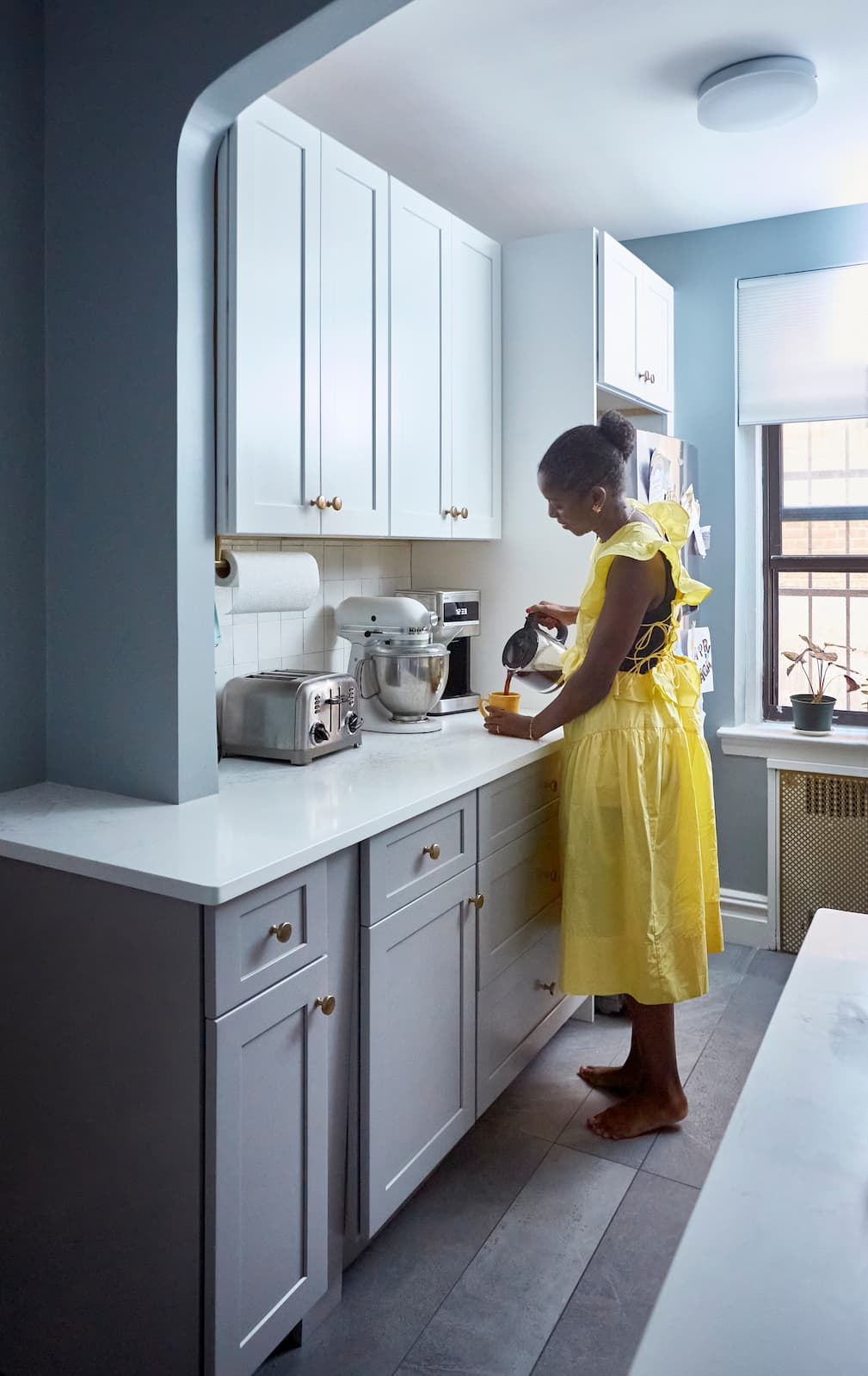
Renovate confidently with Block
Easily compare quotes from top quality contractors, and get peace of mind with warranty & price protections.
Thousands of homeowners have renovated with Block

4.5 Stars (100+)

4.7 Stars (100+)

4.5 Stars (75+)

Philadelphia
Renovating Philly Row Homes: Contractors & Getting Started
08.20.2025
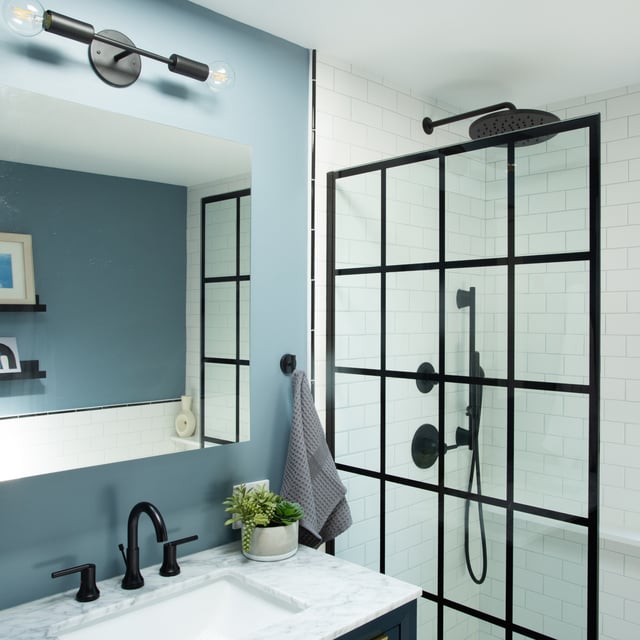
Cost
How Much Does It Cost to Remodel a Bathroom in Philadelphia?
04.28.2025

Philadelphia
An Ultimate Guide to Gut Renovations in Greater Philadelphia
11.07.2024
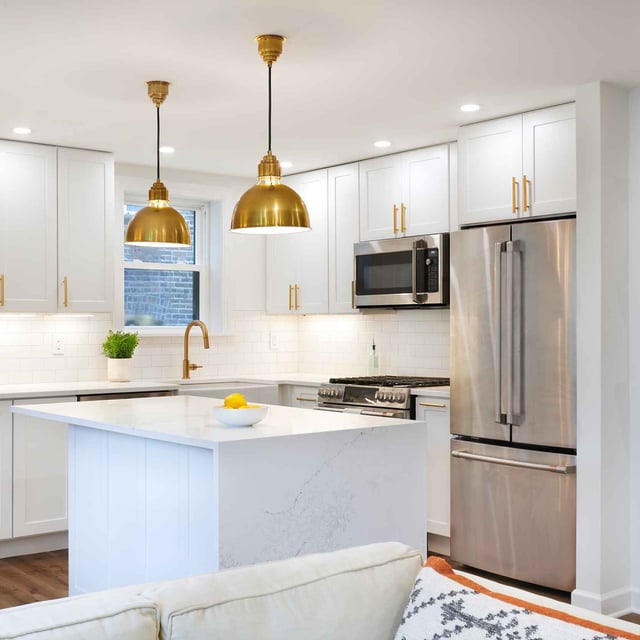
Remodeling
The Ultimate Guide to Home Renovation Costs in Greater Philadelphia
10.16.2024
Renovate confidently